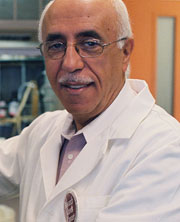
Yusuf Abul-Hajj, MS, PhD
Titles
Education
PhD, University of Wisconsin, 1968
Masters, American University of Beirut, 1964
Bachelors, American University of Beirut, 1962
Biography
Summary
The major emphasis of the work in my laboratory is on the relationship between estrogens and cancer. Estrogens have been shown to induce various tumors in several animal species. Although the exact mechanism for estrogen carcinogenesis is not fully understood, it is believed that metabolic activation of estradiol leading to the formation of catechol estrogens is a prerequisite for its genotoxic activity. Studies in my laboratory are aimed at identifying the nature and the mechanism(s) of estrogen reactive species that may be responsible for the toxicity and/or carcinogenicity of estrogens. Following the discovery of estrogen receptors and their presence in some hormone-dependent human breast tumors, the laboratory has been carrying out studies on the mechanisms of inhibition of mammary tumors by steroidal compounds. The design, synthesis and evaluation of substituted 4-androstenediones, 11ß-substituted estradiol and estrogen-linked cytotoxic agents are currently being investigated as chemical agents for the treatment of breast cancer.